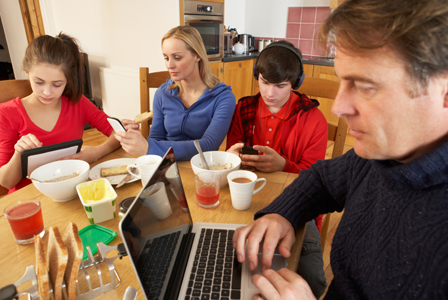 Parents are a child’s first model. Does that work with screens as well? Screenagers explore if this is true or a myth below:
Parents are a child’s first model. Does that work with screens as well? Screenagers explore if this is true or a myth below:
For years parents have said to me, “I know I am part of the problem. I should be modeling screen time better.”
I first respond by validating them in some way, such as, “It is really great that you are thinking and talking about this issue of modeling screen time. It is so important.”
Then, my next response often surprises them. Rather than say something like, “Yes, yes, I know we all need to do that better,” I gently point out that there is a major problem with the goal of “trying to model better” — the problem lies in the ambiguity of the goal — ambiguous goals never go well.
So much of what I do as a doctor is helping patients recognize and try to change unhealthy behaviors. Issues around behavior change are something I have been fascinated with and researching for years. One fundamental aspect of behavior change is choosing a definable and reasonable goal.
So to parents, I say, rather than having a vague goal like, “I should model screen time better,” pick a specific goal, and then model how you are going to try to reach that goal. Helping youth learn skills around behavior change through one’s own efforts is such a valuable gift to them.
For example, I had a habit of reflexively going onto my laptop to work after dinner. Did I really want to do that almost every night of the week? No, I didn’t. Furthermore, I did not want to model this for my kids.
I wanted to change my behavior. So, I decided that every Tuesday I would try to not go back on screens after dinner, and, instead, treat myself to a creative and relaxing evening. I wanted to make earrings and be more available to my family. On the first Tuesday, I completely forgot, and automatically went on my computer. The next Tuesday, I did not do enough prep, so I still had emails I needed to write.
When I failed on those first few Tuesdays, I shared my failure with my kids. I told them about my setbacks, and the actions I would do to try to prevent future failures. After the first week, I put a big reminder on the refrigerator. For the second week, I put a note on Tuesday morning’s to-do list to finish all emails before dinner.
We were all able to laugh at my setbacks, and I was happy to ask them to help me remember my goal.
A goal can be even something like changing the type of shows one decides to watch. Last week, for example, my husband announced to the family that he decided to stop watching the crime-drama, Ozark. He told us the reason he was stopping was that it was adding to his feelings of the bleakness about the world. He said that he didn’t like how the show made him root for people that he did not feel good about cheering for. So, to replace that activity, he planned to start a new book.
Examples of parents setting specific goals
Over the years, parents have told me about screen time behavior changes they wanted to make. They told me variations of the examples I give here.
After checking my email, my goal is to turn off the Wifi on my computer for 1 hour each weekday morning, so I can get my writing done and not get tempted to check my email.
I am going to try to resist checking my phone when we are setting up for dinner and at the table, so I get to talk with my family in a more connected way.
My goal is to take a full weekend off of screens one weekend this month and see how I feel afterward.
I plan to no longer have my phone in my room at night, just like I have decided I don’t want my teens to have theirs.
I plan to delete my favorite sports app off my phone because I check it too often. I want to see if I can keep it off permanently and only look up sports on my computer.
A model for effective behavior change that I love
If you have a change that you would consider announcing and trying, there is a model for behavior change I love in Joshua Klapow’s book, “Living Smart.”
The one from Living Smart goes like this:
S = Set a reasonable small, and actionable goal.
M = Monitor your progress by doing something like noting on a calendar each time you succeed.
A = Arrange for success like I did when I put my beading tray on the kitchen table Tuesday mornings. I knew exactly where it was, and I was ready to go that evening when my screen-free night arrived.
R = Recruit people to help hold you accountable. I told my kids, husband, and some friends about my goal and asked them to ask me about it now and then. Wanting the ego lift of being able to report success, gave me some extra motivation. Honestly, though, knowing my kids were witnesses to my attempts was the strongest motivation. When I slipped-up, I asked them for their suggestions of what I could do, and they loved giving me advice.
T = Treat. My favorite part! Choose a personal reward you value, like having a special dessert. All the data shows that sustained behavior change comes when we get rewards for our change. For example, if one does not like the gym where they do the elliptical, over time, they will stop going. But if they allow themselves to watch their favorite show, only when they are on the elliptical, it can be enough of a reward that they stick with it. Or, they get the reward that they actually start to enjoy the movement of an elliptical.
I don’t mean to say in this blog that modeling screen time is not important or doable — of course, it is both important and doable. But modeling is complex and is a superb topic to be discussing with your kids. Let me give you an example. If a family has a rule that devices are put away at mealtime, it would be a real disconnect if a parent sat on their phone night after night at dinner. If now, and then, the parent has to step away from dinner for an urgent work call, then ideally the parent would say something like, “I am sorry, I have to take this call for work — but I will tell them I will call them back shortly.” This parent is doing a great job of modeling even though they have actually “broken the rule.”
And how did it turn out for me on Tuesday nights? The habit did take hold for a couple of months, and then I decided that I didn’t want to do it anymore. I do continue to work to take nights off from my screen though.
Ideas for conversation starters:
- How do I model screen time? What messages do my actions with my devices signal to you?
- Have you seen me try to change a habit, screen time, or others?
- What do you think of the SMART approach to behavior change?
- Is there anything around my screen time habits that you think I should consider changing?
